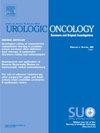Exploring the effect of patient characteristics on the association between warm ischemia time and the risk of postoperative acute kidney injury after partial nephrectomy
IF 2.3
3区 医学
Q3 ONCOLOGY
Urologic Oncology-seminars and Original Investigations
Pub Date : 2025-05-01
DOI:10.1016/j.urolonc.2024.11.002
引用次数: 0
Abstract
Background
The impact of warm ischemia time (WIT) on renal function after partial nephrectomy (PN) remains debated. This study investigates the effect of WIT on the relationship between preoperative comorbidities and postoperative renal function impairment in renal cell carcinoma (RCC) patients.
Methods
Patients undergoing PN for T1 RCC at a European high-volume center (2000–2023) were analyzed. Logistic regressions assessed the association between patient comorbidities and acute kidney injury (AKI). Patients were stratified into low (LR), intermediate (IR), and high-risk (HR) groups based on a weighted comorbidity score derived from odds-ratio obtained from the logistic regression analysis. Interaction terms and a weighted local polynomial smoother function assessed the impact of WIT on AKI. Cox regressions and cumulative incidence were used to assess the chronic kidney disease (CKD) upstage ≥IIIB risk according to AKI and risk groups.
Results
Of 1,048 patients, 802 underwent PN with warm ischemia. Among these, 339(42%), 208(26%), 255(32%) were classified as LR, IR and HR. IR (OR:1.82, P = 0.018) and HR (OR:3.01, P < 0.001) patients had a higher AKI risk compared to LR. The increase in WIT had little impact on the LR AKI probability compared to IR (OR:1.06, P = 0.001) and HR (OR:1.08, P < 0.001). The 10-year risk of CKD-upstage ≥IIIB was higher (36% vs. 12%, HR:2.40, P = 0.004) after AKI, and in the HR group (HR:2.42, P = 0.008)
Conclusions
WIT predominantly affected the risk of AKI in HR patients for renal function impairment after surgery. Preoperative counseling is essential for comorbid patients, especially when planning complex surgeries with prolonged ischemia, to mitigate AKI and long-term renal impairment.

探讨患者特征对热缺血时间与肾部分切除术后急性肾损伤风险关系的影响。
背景:热缺血时间(WIT)对部分肾切除术(PN)后肾功能的影响仍有争议。本研究探讨WIT对肾癌(RCC)患者术前合并症和术后肾功能损害的影响。方法:对欧洲大容量中心(2000-2023)T1期RCC接受PN治疗的患者进行分析。Logistic回归评估了患者合并症与急性肾损伤(AKI)之间的关系。根据logistic回归分析得出的比值比加权共病评分,将患者分为低(LR)、中(IR)和高风险(HR)组。相互作用项和加权局部多项式平滑函数评估了WIT对AKI的影响。根据AKI和风险组,采用Cox回归和累积发生率评估慢性肾脏疾病(CKD)后期≥IIIB风险。结果:1048例患者中,802例患者行PN伴热缺血。其中,339例(42%)、208例(26%)、255例(32%)属于LR、IR和HR。IR (OR:1.82, P = 0.018)和HR (OR:3.01, P < 0.001)患者的AKI风险高于LR。与IR (OR:1.06, P = 0.001)和HR (OR:1.08, P < 0.001)相比,WIT的增加对LR AKI概率的影响较小。AKI后10年ckd≥IIIB的风险更高(36% vs. 12%, HR:2.40, P = 0.004),HR组(HR:2.42, P = 0.008)。结论:WIT主要影响HR患者术后肾功能损害的AKI风险。术前咨询是必要的合并症患者,特别是当计划复杂的手术延长缺血,以减轻AKI和长期肾脏损害。
本文章由计算机程序翻译,如有差异,请以英文原文为准。
求助全文
约1分钟内获得全文
求助全文
来源期刊
CiteScore
4.80
自引率
3.70%
发文量
297
审稿时长
7.6 weeks
期刊介绍:
Urologic Oncology: Seminars and Original Investigations is the official journal of the Society of Urologic Oncology. The journal publishes practical, timely, and relevant clinical and basic science research articles which address any aspect of urologic oncology. Each issue comprises original research, news and topics, survey articles providing short commentaries on other important articles in the urologic oncology literature, and reviews including an in-depth Seminar examining a specific clinical dilemma. The journal periodically publishes supplement issues devoted to areas of current interest to the urologic oncology community. Articles published are of interest to researchers and the clinicians involved in the practice of urologic oncology including urologists, oncologists, and radiologists.

 求助内容:
求助内容: 应助结果提醒方式:
应助结果提醒方式:


